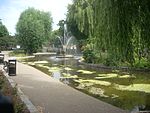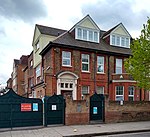Clapton railway station
Clapton, LondonDfT Category D stationsFormer Great Eastern Railway stationsLondon stations without latest usage statistics 1415London stations without latest usage statistics 1516 ... and 6 more
Rail transport stations in London fare zone 2Rail transport stations in London fare zone 3Railway stations in Great Britain opened in 1872Railway stations in the London Borough of HackneyRailway stations served by London OvergroundUse British English from August 2012

Clapton is a railway station on the Chingford branch of the Lea Valley lines, located in Upper Clapton in the London Borough of Hackney, east London. It is 3 miles 78 chains (6.4 km) down the line from London Liverpool Street and is situated between Hackney Downs and St. James Street. The station has been operated by London Overground since 2015. The station is in Travelcard Zone 2 and Zone 3.
Excerpt from the Wikipedia article Clapton railway station (License: CC BY-SA 3.0, Authors, Images).Clapton railway station
Southwold Road, London Clapton (London Borough of Hackney)
Geographical coordinates (GPS) Address External links Nearby Places Show on map
Geographical coordinates (GPS)
| Latitude | Longitude |
|---|---|
| N 51.5617 ° | E -0.0571 ° |
Address
Clapton
Southwold Road
E5 9PY London, Clapton (London Borough of Hackney)
England, United Kingdom
Open on Google Maps







